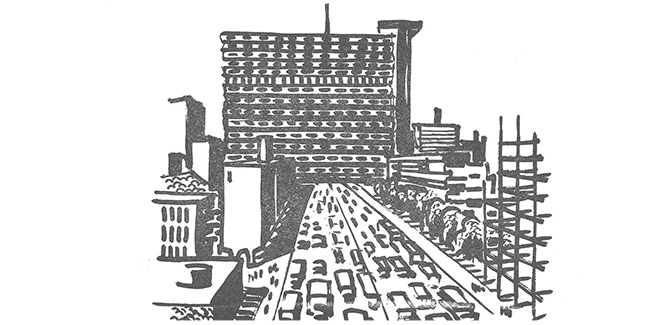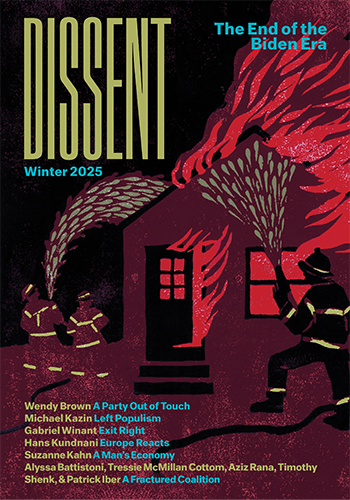Banning Cars From Manhattan
Banning Cars From Manhattan
This article first appeared in our Summer 1961 issue. We are republishing it following the New York state legislature’s recent approval of a congestion pricing plan for New York City.

We propose the banning of all cars from Manhattan Island, except buses, small taxis, vehicles for essential services (doctor, police, sanitation, vans, etc.), and the trucking used in light industry.
The present situation is intolerable and all other proposed solutions of it are uneconomic, disruptive, un-healthy, non-urban or impractical.
With this diminution of traffic, we can, except in certain areas, close off nearly four out of five cross-town streets and every second north-south avenue. These closed roads plus the space now used for off-street parking will give us a great fund of land for neighborhood planning and relocation. (At present over 35 per cent of the area of Manhattan is taken up by the roads.) Instead of the present grid, we can aim at various kinds of enclosed neighborhoods, in approximately 1200 to 1600-foot superblocks. However, it would be convenient to leave the existing street-pattern in the main downtown shopping and business area, in the financial district, and wherever the access for trucks and service cars is imperative. Our aim is to enhance immensely the quality of our city life, with the minimum of disruption of the existing pattern.
The disadvantages of our radical proposal are small. At present, the cars are simply not worth the nuisance they cause. Less than 15 per cent of those daily entering Manhattan south of 61st Street come by private car. The traffic is congested, speed is slow, parking is difficult and increasingly expensive. It is estimated that the cost of new garaging is $20,000 per car; and parking lots are a poor use of land in the heart of a metropolis as well as disruptive of the urban cityscape.
The advantages of our proposal are very great. Important, and immediate, are the relief of tension, noise and anxiety; purifying the air of fumes and smog; alleviating the crowding of pedestrians; the safety of children. Subsequently, and no less importantly, we gain the opportunity of diversifying the gridiron, beautifying the city and designing a more integrated community life. (The expense of an onerous requirement of the Building Code for off-street parking could, of course, be dropped.)
THE PROBLEM and our solution are probably unique to Manhattan, though our experiment would provide lessons elsewhere. Manhattan is a world center of business, buying, style, entertainment, publishing, politics and light manufacture. It is daily visited in throngs by commuters to work, seekers throngs by commuters to work, seekers of pleasure, shoppers, visitors on business, and tourists. We have, and need, a dense population; the area is small and strictly limited. Because of this, Manhattan can easily be a place as leisurely as Venice. It can be a lovely pedestrian city, for it does not sprawl. In the first appendix to Communitas, we developed a scheme for Manhattan paying especial attention to improving the rivers and developing riverside neighborhoods (routing traffic up through the center). We now believe that a first and easy step toward achieving a livable city is the elimination of most of the traffic altogether.
Manhattan has been losing population to the suburbs and near countryside with increase of daily commutation. A more spacious and desirable center would reduce, perhaps stop this trend. And, within the city itself, it is possible to decrease commutation. The ILGWU Housing at 34th Street and the proposed forty-story residential buildings of the Downtown-Lower Manhattan Association show the way. It might be feasible to establish a municipal agency to facilitate people’s living near their work if they so choose, by arranging exchanges o I residence advantageous to all parties. This should be possible in many thousands of cases; it is certainly worth trying.
(This kind of simple expedient is just what our society usually neglects. There is no agency in the city to attend to the multi-purpose problems of community, the integration of the functions of life. Cf. Communitas, Appendix C.)
2. Peripheral Parking
The banned private cars can be accommodated by various kinds of peripheral parking. The idea of peripheral parking has been studied by Louis Kahn and Victor Gruen, as well as the present authors.
At present many thousands of cars of commuters are left at suburban railway stops and at more or less convenient subway stations in Queens, Brooklyn and the Bronx. This is because of the obvious undesirability, from the motorist’s point of view, of driving them into Manhattan. We propose simply to generalize this common sense decision in order to use it as a basis for important further advantages.
We propose, in addition, the construction of multi-purpose piers in the Hudson and East Rivers for parking cars entering at the main bridges and tunnels. These piers could be developed for promenade, recreational and even residential use and might be considered as part of the river development recommended in Communitas.
These piers would be served by bus and taxi. Consider a particular case. A large store, e.g., Macy’s, might provide pier-limousines for commuting shoppers, including the service of delivering packages to the parked cars.
3. Roads
We would keep the broad and highly We would keep the broad and highly 42nd, 57th, 59th, etc., as two-way bus and taxi arteries; and also 1st, 3rd, 5th, 7th, Broadway, 9th and 11th Avenues. These should provide adequate circulation for the residual traffic. (As indicated above, we would keep the existent street pattern in the midtown section—from 23rd to 59th Streets—to serve the shops, theaters, etc., and also wherever there is a special case. Every street would have to be studied individually.)
All other streets would become pedestrian walks which also act as roads for necessary servicing (fire, garbage, mail, etc.).
The proposed grid of through arteries is such that the maximum walk to the nearest bus stop would always be less than a fifth of a mile. Subway entrances would exist as at present. In general, the bus service throughout Manhattan would be expanded, bringing back the 2-deck buses. We must keep in mind that with the ending of congestion and the immense cutting down of pedestrian crossing, the speed down of pedestrian crossing, the speed limit for taxis and express buses could be raised to 25 or even 30 miles an hour. (Since there would be much less need to cross over, it would be possible to eliminate jay-walking, and perhaps provide pedestrian bridges and tunnels.) On the whole, given the improvement of the bus-service, most travel about town would be swifter and more convenient than at present with the private cars.
There would be more taxis. Most of these should be small (half the present length by eliminating trunk space, placing motor under rear seat). It seems absurd for the taxis in a limited speed metropolis to be the same cars designed for travel on super-highways. Best would be electrics.
The remaining gridiron plan of Manhattan is kept; it is practical and when simplified it has a sort of grandeur. But to avoid the boredom of nothing but endless vistas we recommend bridging certain streets with buildings to create other spatial effects. Every street and avenue represents an individual artistic problem.
4. Neighborhood and Community
In the long run, the most valuable ideal for New York or any other vast city is to become a large collection of integral neighborhoods sharing a metropolitan center and metropolitan amenities. The neighborhoods differ since they comprise a wide variety of community functions, administered with relative independence by each neighborhood. Certainly they would not look alike. Consider, for example, that a basically family-residential neighborhood might have a quite autonomous control of its local school, with a certain amount of the neighborhood school-money administered by the local Parents-Teachers Association. The central Board of Education could dictate minimum standards and see to it that underprivileged neighborhoods get a fair cut of the revenue, but it need not stand in the way (as it does at present) of variation and experimentation. Our idea, too, is that local exercise of political initiative on local problems like schooling, housing and planning, would immensely heighten the level of the electorate. A neighborhood should be planned to increase mutual acquaintance of the neighbors and to give them responsibility for the school, market, playground; and such a complex could well serve as the primary municipal electoral unit. Meantime, all the integral neighborhoods share in the great city of the big shops, theaters, hotels, museums and national enterprises. The aim of integral planning is to create a human-scale community intermediary between the individuals and families and the metropolis; it is to counteract the isolation of the individual in the mass-megalopolis. Naturally, in a vast region like New York there will be many thousands of persons who choose precisely to be isolated individuals—that might be why they came here—but these too form a distinctive and valuable element in the federal whole, and they can be provided for in the center and in sub-neighborhoods.
Toward the ideal of such a city of federated communities, the simple device of banning the cars and replanning the gridiron is a major step. The new road-pattern allows for super-blocks of from six to nine acres. (Stuyvesant Town covers sixteen acres.) With plastic invention and aiming at the maximum variety of landscaping, land use and building height, there is here an unexampled opportunity for dozens of eventual solutions that could surpass in urbaneness and amenity the squares and crescents of 18th Century London. There is space for recreation and play. (The length of a tennis court fits across 9th Avenue; an occasional corner is big enough for a softball field.) Given the large fund of newly available land, now wasted on largely unnecessary and always inconvenient traffic and parking, it is possible to develop neighborhoods in a leisurely fashion, with careful study and with no problems of relocation or dislocation of such neighborhood ties as still exist. We would especially recommend competitions and public referenda, in order to avoid bureaucratic imposition and to educate the community to awareness and concern.
5. Means, etc.
The legal problem of the proposed ban should not be difficult. Streets are at present closed off for play and other purposes. The Mayor banned all traffic in the emergency of snow clearance (though his right to do so has been disputed). We have had a vehicle tax; it could be so pegged as to be prohibitive. A prohibitive entry fee could be charged.
The ban should, of course, be leniently enforced to allow for special cases and emergency use (e.g., a family starting out on a trip and loading up). Likewise there must be provision for cars to pass over Manhattan, going east and west.
It is likely that the ban on cars could be lifted on weekends, when the truck and bus traffic is much diminished. Especially during the warm months this would be a great convenience for week-end trips.
6. Conclusion
The above proposal is simple common sense. The cars have caused many and increasingly severe ills, so that the situation is admittedly reaching a crisis. The proposed solutions—new traffic regulations, new highways, multi-levels, underground parking—all bear the typical earmark of American planning: to alleviate an evil by remedies that soon increase the evil. But in this special case of Manhattan, the elementary radical remedy, of getting rid of the cars, would cause very little hardship and have immense and beautiful advantages. (In sprawling cities like Los Angeles or Cleveland, of course, one cannot get rid of the cars.)
To anyone interested in community planning, the chief advantage of our proposal is that it provides opportunity. It does not merely remedy an evil or provide a way to do the same things more efficiently, but it opens the possibility to think about ideal solutions, human values and new ways to do basic things. In general, most big-scale planning and most of what passes for Urban Renewal are humanly indifferent. The quality of life in our city will not be improved by such planning, but by some elementary social psychiatry and common sense.
Finally, conceive that one of our mayoral candidates were convinced of the advantages of this proposal and made it a part of his program in running for office. This is hard to conceive, because it is just such concrete issues that are never offered to the voters; the voters never have real choices to think about, therefore they never learn to think. Instead they vote for personalities and according to ethnic and party groupings; whereas the rival programs are both vague and identical.
If, however, such a plan as this were offered as an important issue, our guess is that the candidate would lose this year, because he would be considered radical and irresponsible; and he would win next time around, when people had had a chance to think it through and see that it made sense.
Download the full article as a PDF




